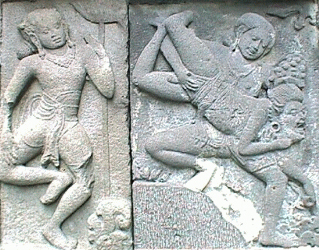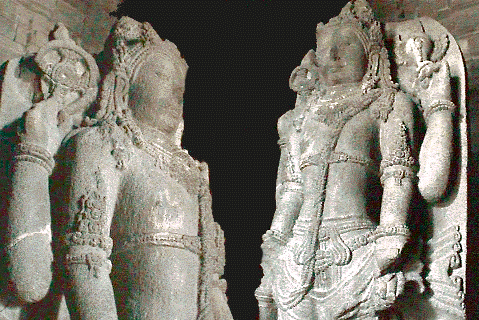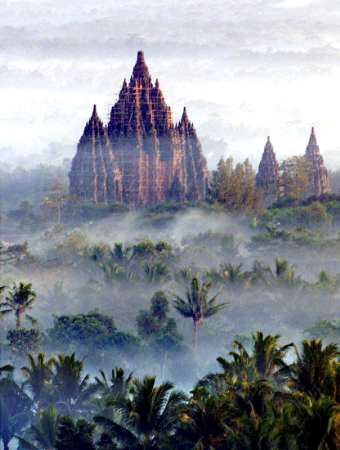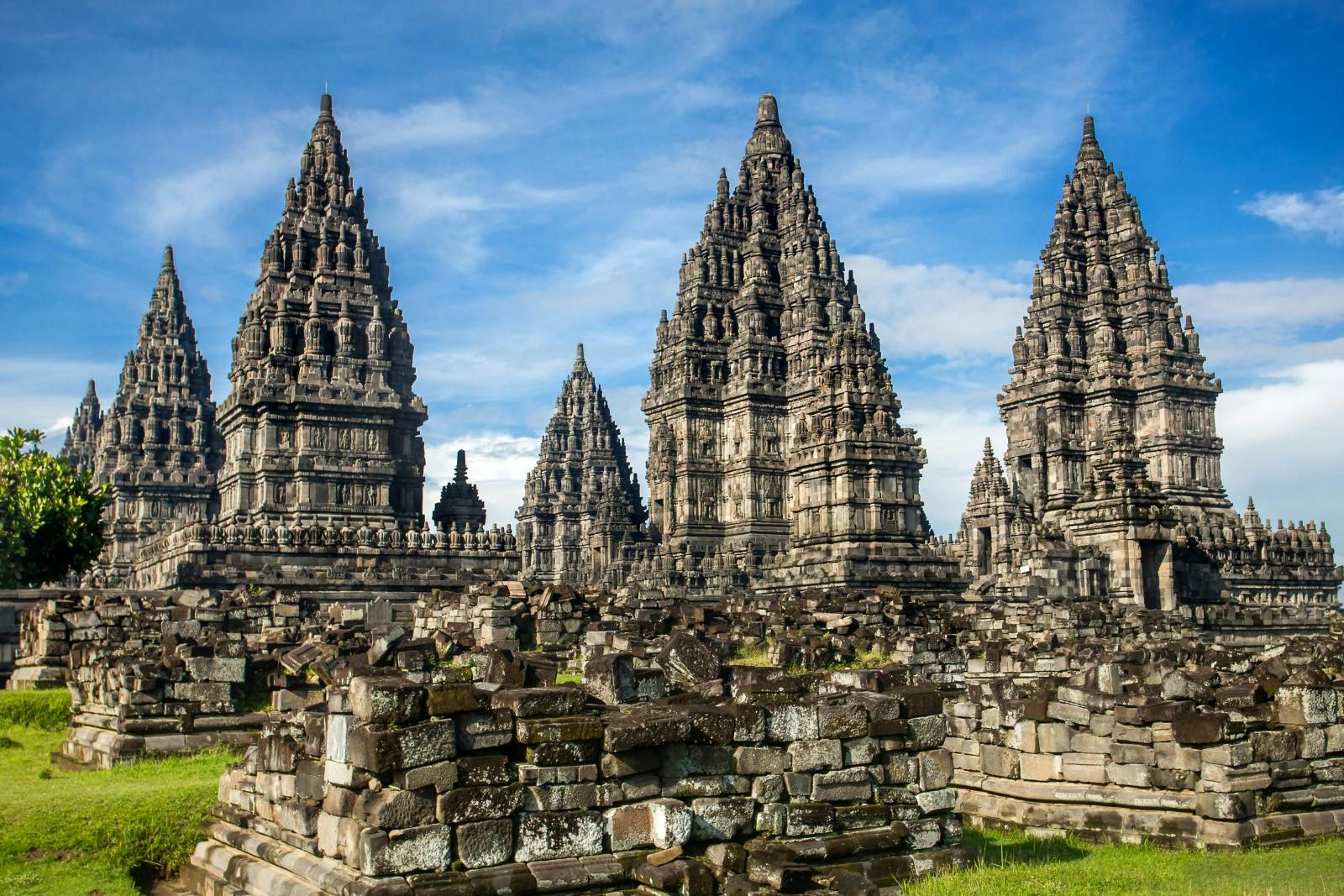Lord Vishnu at Prambanan
BY: SUN STAFF - 29.7 2022

Prambananan Visnu Temple at Sunset
The first in a presentation of the Vishnu temples of Central Java.
"The crystal temple was comparable to Mount Mandara,
the square to the Milk Ocean.
Gems and pearls represented the foam, so to speak;
the clear cold water was like nectar
(rising from the churned ocean)....
"Outside there were...small and exquisitely fine temples,
all carved out of black precious stones...
[that contained] gold statues comparable to
the gods and demons attacking each other
in order to obtain the elixir of immortality (amrita)...."
--The Old Javanese Ramayana Kakawin
The only central Javanese temple complex to approach the magnificence of Java's Borobudur in terms of overall size as well as both the extent and the beauty of its narrative bas-reliefs is the Loro Jonggrang templex complex at the town of Prambanan, which is located to the east of the modern city of Yogyakarta. The central courtyard of this Hindu religious foundation features three tall shrines dedicated to Brahma (south), Shiva (center) and Vishnu (north), respectively.

Left: Balarama looks on as his brother Krishna defeats his opponant in a wrestling contest.
Right: Rama slays King Sugriva's foe Subali.
At Prambanan, the narrative reliefs portray episodes from two of the Lord's incarnations. The bas-reliefs pertaining to the Lord's incarnation as Sri Krishna appear on the interior-facing walls of the balustrade that surrounds the Vishnu shrine, while episodes from the Lord's incaration as Rama encircle the main shrines at Prambanan that are dedicated to Shiva and Brahma
"The fact that these reliefs were carved into the holiest of holy edifices of the period should of course in itself be a caution to exercise particular care and resignation where the actual disposition does not entirely meet our expectations.... Their interpretation is especially fraught with difficulties. To begin with, we find the story of Rama distributed over two of the three temples located here, namely the Shiva and the Brahma temple, while actually we would have expected the Vishnu temple to be a pre-eminently suitable candidate for adornment with stories of the Vishnu avatar Rama. By the same token we would have expected to find tales of Shiva depicted on the Shiva temple, whereas the first figures to be noted in the reliefs adorning this temple are those of Garuda (Vishnu's half-man/half-bird vehicle) and the second Vishnu himself!" (3)

Lord Vishnu at Prambanan
A possible answer to this question can be found in the Ramayana Kakawin, an indigenous rendition of India's legendary account of the life of King Rama that many scholars believe was composed during the mid-ninth century CE at the close of Central Java's temple-building period. Like Prambanan's instription of consecration, the Ramayana Kakawin describes a temple consequence that is similar in many respects to the one at Prambanan. An inscription of unknown origin dating from 856 CE not only describes the consecration of a temple complex called the abode of the Hindu god Shiva (Shiwagrha), but also presents the funeral poem of Rakai Pikatan, the Hindu sovereign of Central Java during the mid-ninth century CE. Furthermore, this inscription includes a series of Old Javanese verses that describe a temple complex with many similarities to the one at Prambanan. It therefore stands as the earliest known example of the island's indigenous literary tradition.
"Like most Javanese inscriptions, it is a legal document -- confirming the granting of a freehold by a king to a village official; unlike the others, however, it is written in verse. It is a short poem of twenty-nine stanzas written in a Sanskrit poetical form called Kakawin in Old Javanese--a derivative of the Sanskrit-derived word kawi ('poet'). Within these twenty-nine stanzas the poet demonstrates his ability to use no less than six different meters, as well as his mastery of difficult literary devices from the Indian tradition."(1)

Scene from Ramayana
"It was a beautiful dwelling for the God.
At the gateways two small buildings had been erected
that were different in construction from all the others.
Beautful were the number of small buildings
that were there to be used as hermitages,
and which might, in their turn,
serve as an example for others.
"A Tanjung tree was located on the eastern side.
Although its stem was only a year old,
it was able to achieve matchless growth
by residing in the neighborhood of the Lord.
Its extraordinary beauty was equal
to that of the divine Parijataka tree.
Under its very branches the God would descend
so that it might serve as His parasol.
Was it not a veritable God for the Gods?
The smaller buildings were of equal height,
All serving the same purpose and expressing the same thoughts,
but each different from the others by their number.
Who would ever hesitate to worship here?
Out of reverence the people gave.
"In a moment, the temples with their gateways
and innumerable, immoveable carved figures of women,
were completed by the surveyors working by the hundreds.
What would be comparable with this divine edifice,
which was there for a deification?
Was this the reason why the spectators
were overwhelmed at seeing it
and why their every-day sensations failed to come back?
"The worshippers came in rows and in groups,
by the hundreds without saying a word.
Extraordinary were their names,
a token that they the images they worshipped
would bring them refreshment.
Who, then, would not be the very first to go and see?
It was very charming...."
Again, one of the most puzzling aspects of Prambanan's architectural design is the inescapable fact that the temple's three main shrines present narrative reliefs pertaining to the Lord's incarnations as Rama and Krishna. If, as the above-quoted inscription proclaims, Prambanan was indeed dedicated to Shiva then why didn't the temple's architect portray episodes illustrating Shiva's spiritual career?
And after the abode of Shiva had been completed in all its divine splendor, the course of the nearby river was altered so that it would ripple along the temple grounds. "There was no danger from the evil spirits, for they had received their due (offerings); then the grounds were inaugurated as temple grounds...." (2)

Prambanan Temple Architecture
The Hindu temple complex at Prambanan is based on a square plan that contains a total of three yards, each of which is surrounded by four walls pierced by four large gates. The outermost walled perimieter, which originally measured about 390 m per side, was oriented in the northeast, southwest direction. However, except for its southern gate, not much else of this enclosure has survived down to the present.
The two walled perimeters that surround the remaining two yards to the interior are oriented to the four cardinal points. The second yard's walled perimeter, which measures about 225m per side, surrounds a terraced area that consists of four rows containing 40, 48, 56, and 64 temples, respectively, each with a height of 14m and measuring 6m x 6m at the base, or 224 structures in total. The sixteen temples located at the corners of the rows face two directions; the remaining 208 structures open to only one of the four cardinal directions.
The monument's remaining walled perimeter, which measures 110m x 112m, surrounds an even higher terraced courtyard that supports an additional sixteen shrines. The central yard's three largest temples, which face the cardinal direction east, feature large stone statues of the Hindu deities Vishnu (north), Shiva (center) and Brahma (south).
The centrally-located Shiva temple has a height of 47m and measures 34m x 34m at its base. The Brahma and Vishnu shrines to the south and north of the Shiva temple are 33m in height and measure 20m x 20m at the base. The inside facing walls of the balustrades that surround the central structures of these three shrines are covered with bas-reliefs that present episodes from the Lord's incarnations as Krishna (in the Vishnu temple) and Rama (in the Shiva and Brahma temples).
Source: Excerpted from Borobudur.tv







































